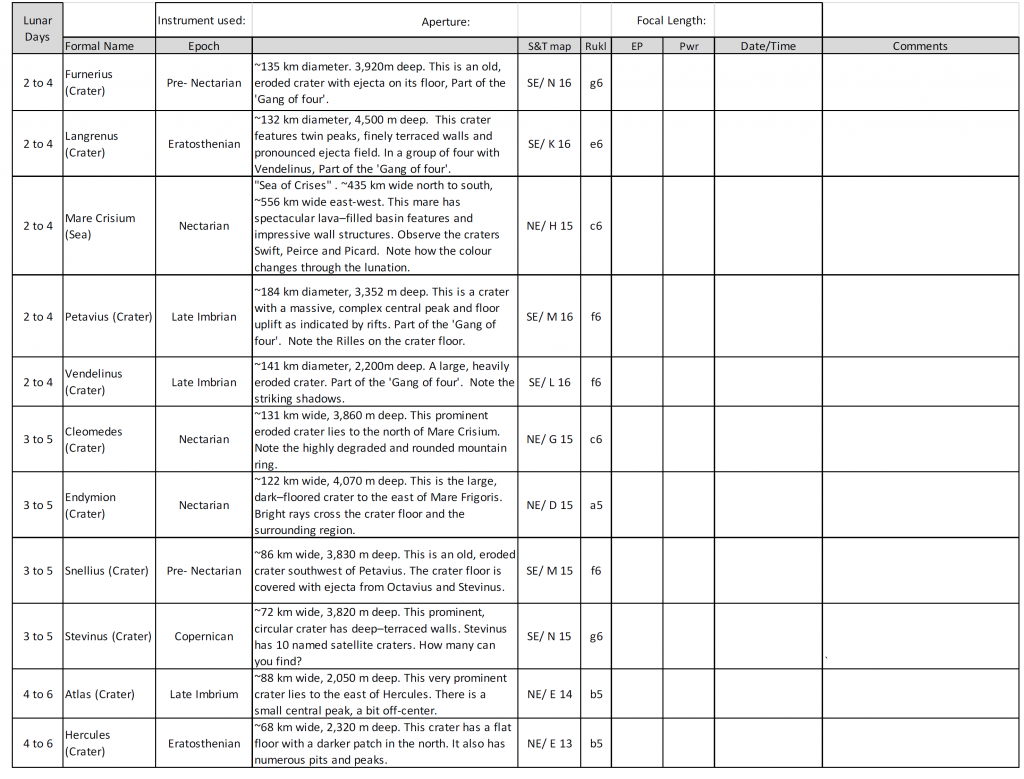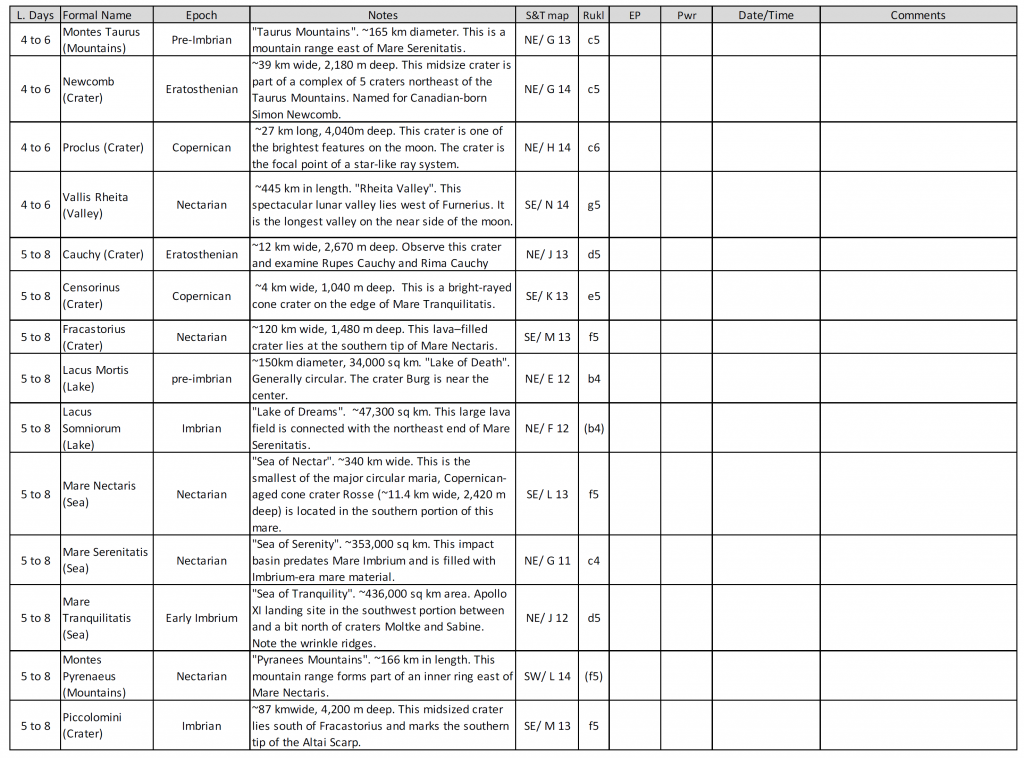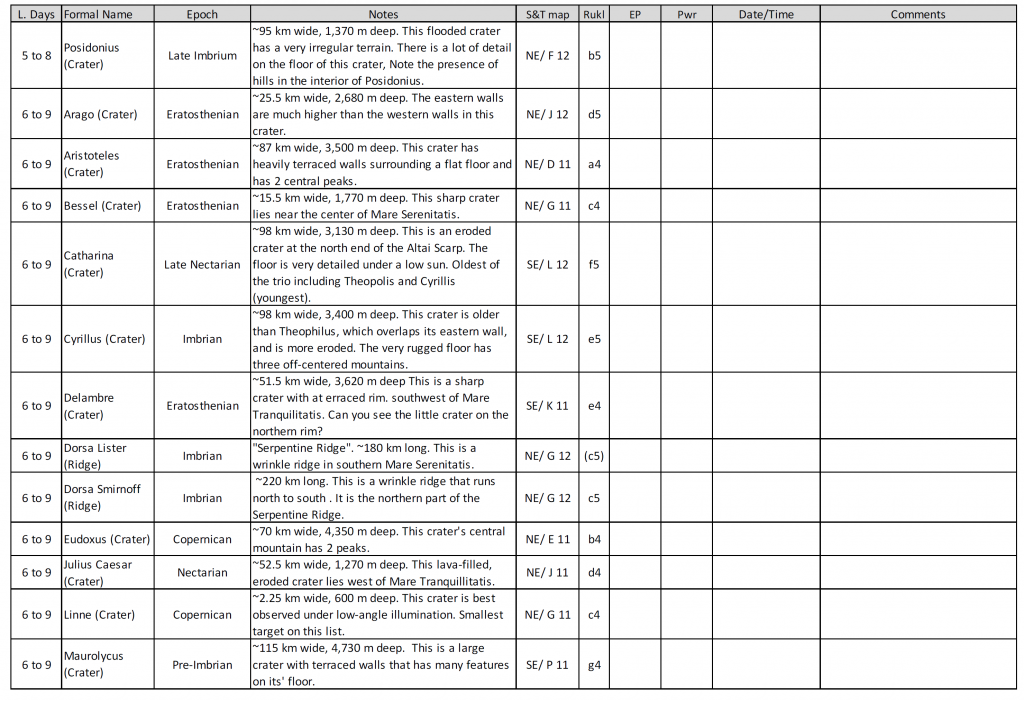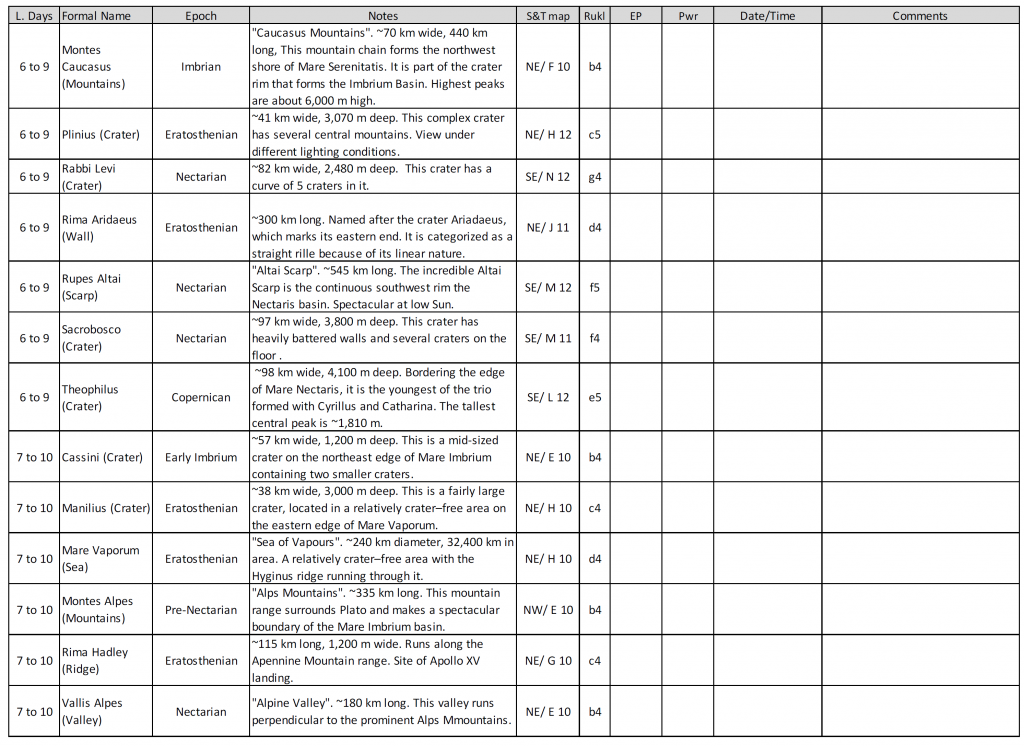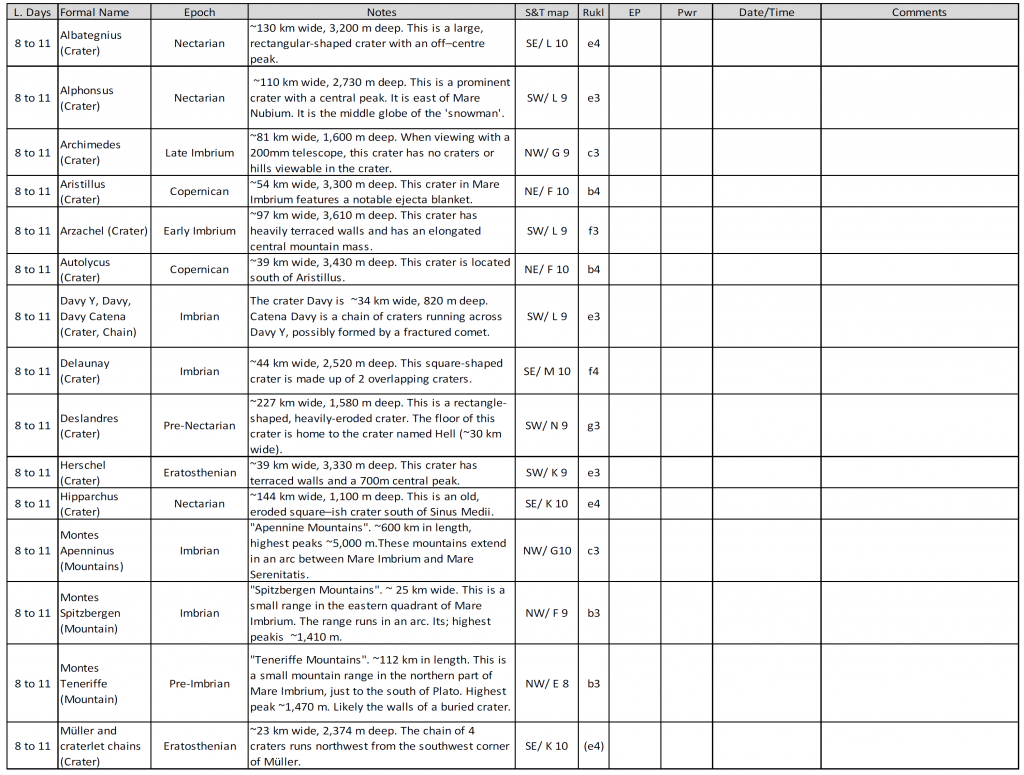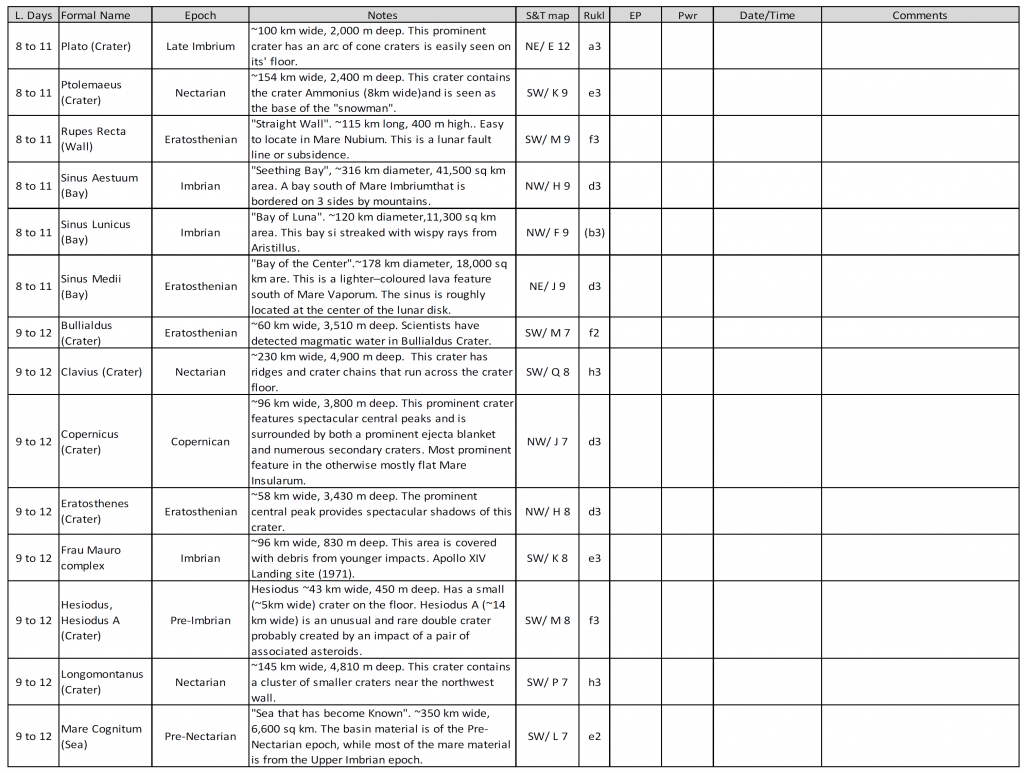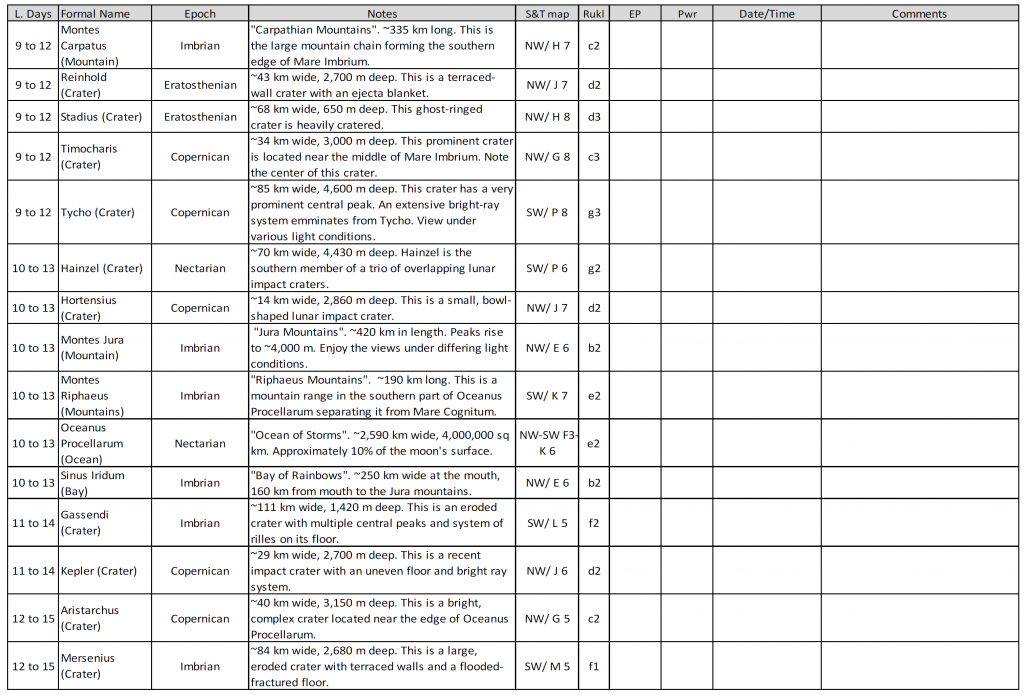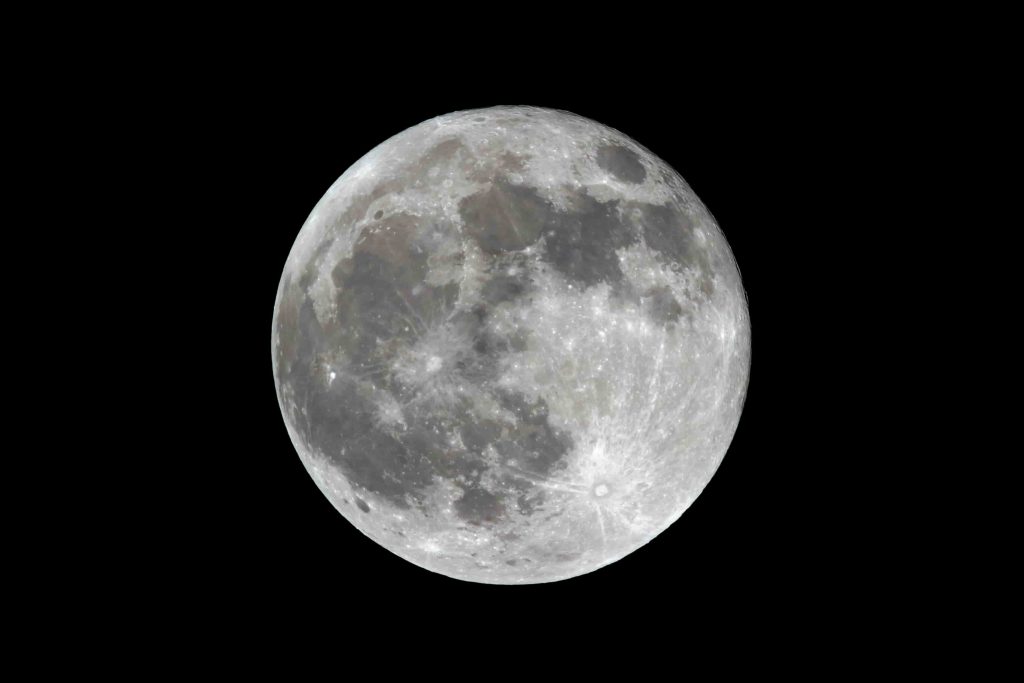Download in PDF format
The Lunar Observing Program introduces participants our nearest neighbour, the Moon – an
object that some observers have come to loathe when they are imaging the deep sky. As is the case,
the moon is easily viewed even when conditions are less than perfect.
This program gives them something to do when the moon is up. In other words, it gives us something
to observe the rest of the month. The Lunar Observing Program also allows amateurs in heavily
light polluted areas to participate in an observing program of their own. This program is well
suited for the young, inexperienced observer as well as the older observer just getting into our
hobby since no special observing skills are required. It is well balanced because it
develops naked eye, binocular, and telescopic observing skills.
The Moon is an ideal object for new telescope users. It’s big, bright, and visible almost every
night. Take your telescope outside and point it toward the Moon. Note its current phase— crescent,
half, gibbous, or full—and whether it’s waxing or waning. You can even capture a photo of the Moon
by aligning your smartphone camera over the telescope’s eyepiece or using a special adapter.
We have made it as simple as possible to log your observations. Just list the instruments that you
used where requested at the top of pages of the checklist, check off the features as you observe
them in the “Observed” column, and then list the date and time in the appropriate columns on the
right-hand side of the checklist. Simple sketches are optional, but not required.
Great artistic ability is not required… we are not trying to turn you into an artist.
Stages in Lunar Evolution
Epoch
The lunar geological timescale (or selenological timescale) divides the history of Earth’s Moon into five generally recognized periods: the Copernican, Eratosthenian, Imbrian (Late and Early epochs), Nectarian, and Pre-Nectarian. The boundaries of this time scale are related to large impact events that have modified the lunar surface, changes in crater formation through time, and the size-frequency distribution of craters superposed on geological units. The absolute ages for these periods have been constrained by radiometric dating of samples obtained from the lunar surface. However, there is still much debate concerning the ages of certain key events, because correlating lunar regolith samples with geological units on the Moon is difficult, and most lunar radiometric ages have been highly affected by an intense history of bombardment.
Pre-Nectarian
The Pre-Nectarian period is defined from the point at which the lunar crust formed, to the time of the Nectaris impact event. Nectaris is a multi-ring impact basin that formed on the near side of the Moon, and its ejecta blanket serves as a useful stratigraphic marker. 30 impact basins from this period are recognized, the oldest of which is the South Pole–Aitken basin. This geological period has been informally subdivided into the Cryptic and Basin Groups 1-9,[1] but these divisions are not used on any geological maps. Examples found in this program: Furnerius, Montes Alps, Grimaldi.
Nectarian
The Nectarian period encompasses all events that occurred between the formation of the Nectaris and Imbrium impact basins. 12 multi-ring impact basins are recognized in the Nectarian period, including the Serenitatis and Crisium basins. One of the scientific objectives of the Apollo 16 mission was to date material excavated by the Nectaris impact basin. Nevertheless, the age of the Nectaris basin is somewhat contentious, with the most frequently cited numbers being 3.92 Ga, and less frequently 3.85 Ga. Recently, it has been suggested that the Nectaris basin could be, in fact, much older at ~4.1 Ga.
Examples found in this program: Mare Crisium, Cleomedes, Vallis Alpes.
Imbrian
The Imbrian period has been subdivided into Late and Early epochs.
The Early Imbrian is defined as the time between the formation of the Imbrium and Orientale impact basins. The Imbrium basin is believed to have formed at 3.85 Ga, though a minority opinion places this event at 3.77 Ga. The Schrödinger basin is the only other multi-ring basin that is Lower Imbrian in age, and no large multi-ring basins formed after this epoch. Examples found in this program: Mare Tranquilitatis, Cassini, Arzachel.
The Late Imbrian is defined as the time between the formation of the Orientale basin, and the time at which craters of a certain size (DL) have been obliterated by erosional processes. The age of the Orientale basin has not been directly determined, though it must be older than 3.72 Ga (based on Upper Imbrian ages of mare basalts) and could be as old as 3.84 Ga based on the size-frequency distributions of craters superposed on Orientale ejecta. About two-thirds of the Moon’s mare basalts erupted within the Upper Imbrian Series, with many of these lavas filling the depressions associated with older impact basins.
Examples found in this program: Petavius, Atlas, Catherina.
Eratosthenian
The base of the Eratosthenian period is defined by the time at which craters on a geological unit of a certain size DL have been almost obliterated by erosional processes. The principal erosional agent on the Moon is impact cratering itself, though seismic modification could play a minor role as well. The absolute age of this boundary is not well defined, but is commonly quoted as being near 3.2 Ga. The younger boundary of this period is defined based on the recognition that freshly excavated materials on the lunar surface are generally bright and that they become darker over time because of space weathering processes. Operationally, this period was originally defined as the time at which impact craters lost their bright ray systems. This definition, however, has recently been subjected to some criticism as some crater rays are bright for compositional reasons that are unrelated to the amount of space weathering they have incurred. If the ejecta from a crater formed in the highlands (which is composed of bright anorthositic materials) is deposited on the low albedo mare, it will remain bright even after being space weathered.
Examples found in this program: Eratosthenes, Langrenus, Newcomb.
Copernican
The Copernican period is the youngest geological period of the Moon. Originally, the presence of a bright ray system surrounding an impact crater was used to define Copernican units, but as mentioned above, this is complicated by the presence of compositional ray systems. The base of the Copernican period does not correspond to the formation of the impact crater Copernicus. The age of the base of the Copernican is not well constrained, but a commonly quoted number is 1.1 Ga. The Copernican extends until the present day. Examples found in this program: Copernicus, Theophilis, Autolycus.
What’s the smallest object I can see on the Moon?
I am sure that many Amateurs, while participating in an outreach program, have been asked by visitors if you could show them the flag left the Apollo astronauts or maybe any other hardware such as the rovers.
Generally,
The resolution of your 203 mm (8”) telescope is as follows:
Formula: 116 / Telescope Aperture (mm)
So: 116 / 203= 0.57 arcseconds
Resolution:
An 8″ scope would be able to resolve to 0.58 arc seconds.
Apparent diameter of the moon in arcseconds:
Let’s assume the moon is 30 arc minutes (1800 arc seconds).
True diameter of the moon is ~3473 km.
So 3474/1800 = 1.93 Km per arc second.
1.93 * 0.57 = 1.12 km
So, using your 8” (2030 mm) scope you can resolve down to about 1.12 km.
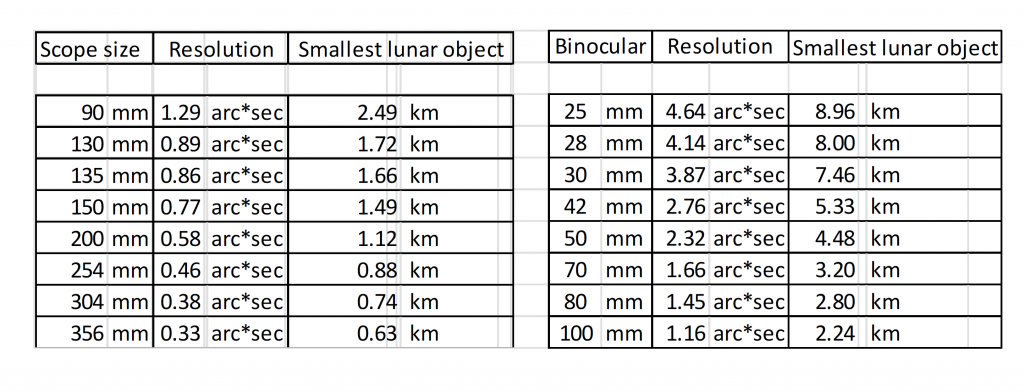
Note that these are only simple calculations; many other particulars come into play as well, such as seeing conditions, properties of the telescope or binocular optics, wavelength of the light. Changes in the orbit of the moon cause changes to the distance from the earth and the apparent size of the moon. Of course, there is always the variation in each observer’s eyesight.
Why can’t I see the Lunar Landing Sites?

To see the 4-meter lander on the moon you would need an earth-bound telescope with an aperture of about 56.84 meters diameter
Glossary:
Epoch: The lunar geological timescale (or selenological timescale) divides the history of Earth’s Moon into five generally recognized periods: the Copernican, Eratosthenian, Imbrian (Late and Early epochs), Nectarian, and Pre-Nectarian.
Basin: Features larger than 300 kilometers in diameter are termed impact basins. More than 40 such basins have been identified on the Moon. These basins control much of the Moon’s geology. For example, mare basalts are mainly confined in the topographic depressions produced at the centers of these basins.
Catena: A chain of craters connected in a series.
Cone Crater: A cone built around a volcanic vent by lava extruded from the vent. A surface depression feature whose internal cross-section is conical.
Crater: Craters come in two flavors: those that aren’t caused by asteroids or comets, impact craters, are formed by powerful volcanic explosions. Such outbursts can be violent enough that once the eruption is over, the volcano collapses in on its empty vacant magma chamber and forms a caldera, or volcanic crater.
Dorsa, Dorsae: Quite simply, a ridge. Dorsa usually occur in the lava flooded plains and maria.
Ejecta: Material displaced by the formation of a crater or basin.
Ejecta blanket: A deposit of ejecta from a crater or basin the thickness of which decreases with the distance from the rim of the crater or basin. Generally, ejecta blankets on the moon appear as a gray spatter-like pattern around a crater, with rays emanating from the vicinity of the source crater.
Fault Line: A displacement in the crust. Evidence of crustal motion during the formation of the lunar surface.
Flooded Crater: A crater that has had its floor flooded with lava through cracks in the floor.
Gang of Four: The name given to the group of four craters, namely Fernerius, Petavius, Vendalinus, and Langrenus.
Ghost Ringed Crater: A heavily eroded or nearly buried crater that has almost disappeared due to being filled with ejecta or lava flows.
Lunar Day: The rotational period of the moon. Equal to the sidereal month. The length of lunar day is 24 hours, 48.76 minutes.
Lunation: The period of time from one New Moon to the next. Approximately 29.53 days.
Magmatic Water: Water that is dissolved in a magma (molten rock material) or water that is released from a magma. Some magmas can contain up to several percent dissolved water by weight.
Mare, Maria: Once thought to be bodies of water, maria are the level, grayish plains of lava on the Moon.
Mare material: Masses of volcanic lava that erupted onto the lunar surface.
Montes: Latin for “mountains”.
Ray System: The nature and origin of lunar ray systems have long been the subjects of major controversies. It is the remains of material ejected from an impact crater during the crater’s formation.
Rift: Fissures along the surface of the moon that produced an outpouring of lava that flooded the current maria.
Rille(s): A reference to any trench-like feature on the lunar surface.
Scarp: Simply a cliff. A relatively straight-lined, near-vertical cliff or slope.
Sinus: In lunar terms it is a gulf or a bay.
Subsidence: The downward shift in the ground surface that can be caused by a variety of processes
Wrinkle Ridge: A meandering ridge.
References:
Atlases:
21st Century Atlas of the Moon, Wood, Collins. West Virginia University Press.
The Hatfield Lunar Atlas, A Digitally Remastered Edition, Cook, Springer Press
The Six-Inch Lunar Atlas, A Pocket Field Guide, Spain, Springer Press
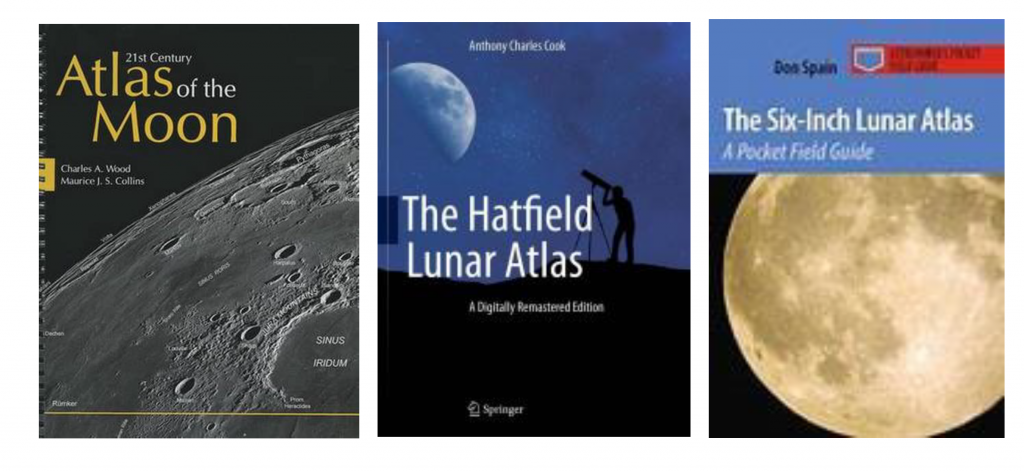
Texts:
Moon Observer’s Guide Second Edition, Grego, Firefly Press
Exploring the Moon Through Binoculars and Small Telescopes, Cherrington Jr. Dover
What’s Hot on the Moon Tonight? Planck, Moonscape Publishing.
50 Things to See on the Moon: A first-time stargazer’s guide, Read, Stellar Publishing
Lunar Cognitum, Garfinkle, Springer Press, 3 Volumes

Maps
Field Map of the Moon, Rukl, Sky and Telescope
Field Map of the Moon Mirror Image, Rukl, Sky and Telescope
Lunar 100 Card, Wood, Sky and Telescope
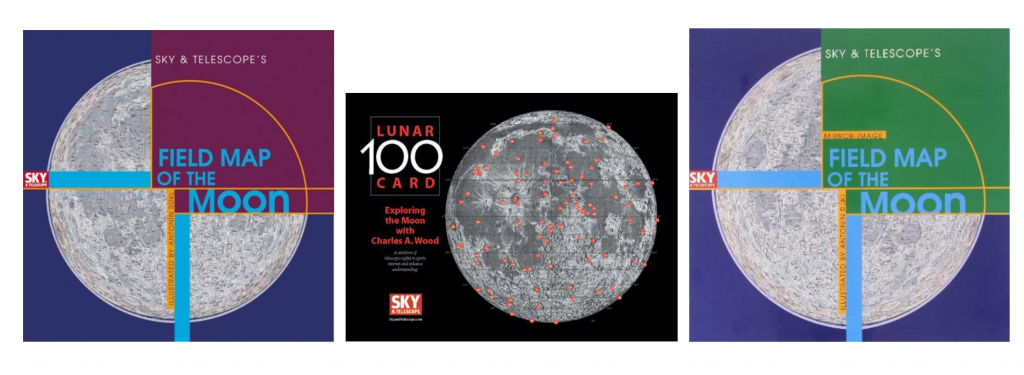
Internet:
https://planetarynames.wr.usgs.gov/Page/MOON/target
http://www.inconstantmoon.com/atlas.htm RUKL
https://www.fourmilab.ch/moontoolw/
https://virtual-moon-atlas.en.uptodown.com/windows download
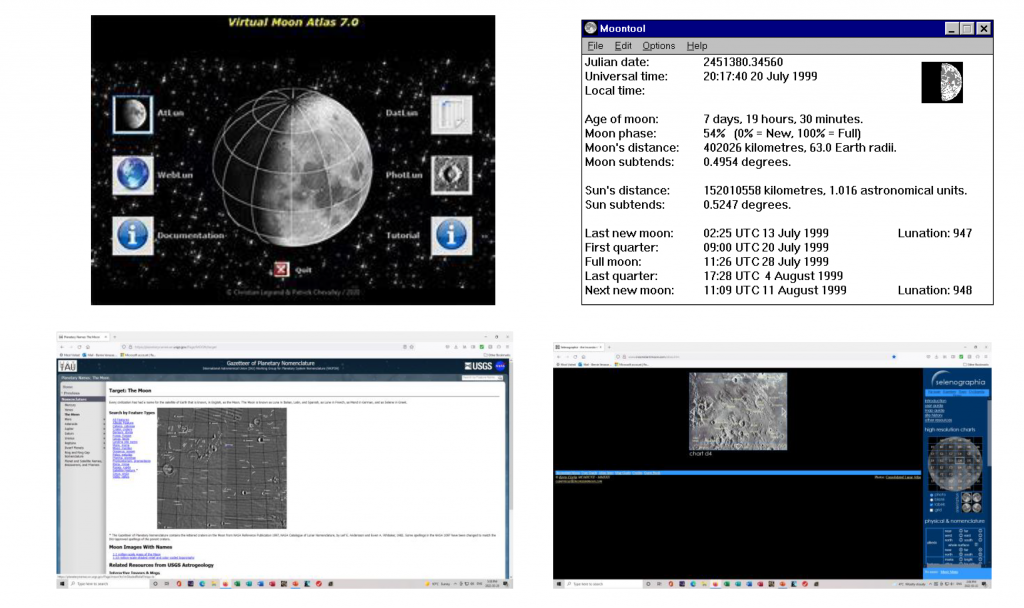
Lunar Observing Program Award Submission Form
Name as you would like to have
it appear on the certificate: ____________________
Phone: _____________________________________
Email: _____________________________________
Address: _____________________________
I am submitting my observation information for the Lunar Observing Award
_ I prefer to have my certificate presented at a general meeting of the H.A.A. I prefer to pick up my certificate (no presentation) at a general meeting of the H.A.A.
__ I prefer to have my certificate mailed to me.
Certification: I certify that I have followed the rules of this program.
X
Scan pages and submit to: awards”at”amateurastronomy.org
Understanding and Using the Checklist
Equipment: If you use the same telescope throughout the program just list it at the top of the page and only indicate the various eyepieces and filters that you use.
L.Day: The lunar days indicated represent the number of days after the New Moon and are arguably the best range of days to observe the target. It is suggested that you observe the changes in appearance of the targets as the lunation day progresses.
Formal Name: This is the official name of the target as given by the International Astronomical Union (IAU) Working Group for Planetary System Nomenclature (WGPSN). Common names are provided in the “Notes” column.
Epoch: This column identifies the epoch of each target in hopes that it will assist you in identifying the target. More about Epochs in the appendix.
Notes: This column is for your impressions or comments about what you saw.
S&T map: The reference location where the target can be found on the Sky and Telescope Field Map of the Moon.
Rukl: This column provides the reference location on the map provided by Rukl as presented by may publications and sites including http://www.inconstantmoon.com/atlas.htm
PWR: The magnification that you used viewing the moon.
magnification = focal length of telescope / focal length of eyepiece. Example: using a 10mm eyepiece in a telescope with a focal length of 1000mm results in a magnification of 100x (1000 / 10 = 100).
Date/ Time: Spell out the name of the month! It will stop confusion later. 5/12/2022 is either May 12, 2022, or December 5, 2022. Indicate AM or PM in your report. Better yet, Use the 24-hour clock method, e.g., 18:15. Use either UTC or local time, but be consistent.
Example

